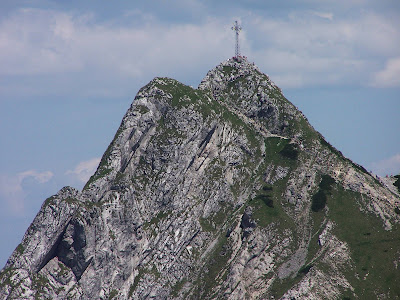The Troll Wall (Norwegian: Trollveggen) is part of the mountain massif Trolltindene (Troll Peaks) in the Romsdalen valley, near Åndalsnes and Molde, on the Norwegian west coast. Trollveggen is part of the Reinheimen National Park in the municipality of Rauma in Møre og Romsdal county. The Troll Wall is the tallest vertical rock face in Europe, about 1,100 metres (3,600 ft) from its base to the summit of its highest point. At its steepest, the summit ridge overhangs the base of the wall by nearly 50 metres (160 ft). The Rauma River and the European Route E136 runs just to the east of the wall.
The rock is gneiss, formed into a broken rock wall of huge corners, concave roofs, and crack systems, topped with a series of spires and pinnacles on the summit rim. The rock is generally loose, and rockfall is the norm on this north-facing big wall. There was a series of large rockfalls on the wall in September 1998, radically changing the character of several climbing routes.
The Troll Wall has been a prestigious goal for climbers and BASE jumpers alike. In 1984, Carl Boenish, the "father" of BASE jumping, was killed on the Troll Wall shortly after setting the world record for the highest BASE jump in history. BASE jumping from Troll Wall has been illegal since 1986.
Climbing history
The Troll Wall was first climbed in 1965 by a Norwegian team. The Norwegian team, consisting of Ole Daniel Enersen, Leif Norman Patterson, Odd Eliassen, and Jon Teigland, finished one day ahead of the British climbers Tony Howard, John Amatt and Bill Tweedale, who established the most popular climbing route on the wall, the Rimmon Route. As of 2003, this route was reported unclimbable because a rockfall in September 1998 destroyed five of its pitches.
The wall saw its first winter ascent in March 1974, when a Polish team spent 13 days repeating the 1967 French Route. In 1979, the wall was free climbed for the first time by local climber Hans Christian Doseth and Ragnhild Amundsen.
Today, there are many routes on the wall, ranging in length and difficulty. The classic Rimmon and Swedish routes were normally free climbed in a day or two until being heavily damaged by the 1998 rock falls. The longer and more engaging aid routes, such as the 1972 test piece Arch Wall (climbed by Ed and Hugh Drummond in 20 days), or the 1986 Death to All/Pretty Blond Vikings, which cuts through the steepest part of the wall, require advanced knowledge of big wall climbing and several days on the wall.
Due to the serious character of the wall, in addition to a cold and damp climate, new routes on Troll Wall are rare. The most recent contribution is the Krasnojarsk Route, established by a Russian team during 19 days in February 2002.
Recent ascents
In July 2010, Arch Wall, previously a serious aid route of difficulty up to A4+, saw its first all-free ascent by local climber Sindre Sæther and his father, Ole Johan. Arch Wall is about 1,200 metres (3,900 ft) of climbing over 37 pitches, and it took the two a total of 36 hours of climbing to reach the summit.
BASE Jumping
In 1980 a new sport appeared when the Finnish Jorma Öster made the first jump with parachute off the Troll Wall.
The Troll Wall has also gained notoriety as a favourite haunt of BASE jumpers. It was one of the sites where BASE jumping was pioneered in the eighties, until Norwegian authorities made BASE jumping from the Troll Wall illegal on July 25, 1986. Parachute equipment that wasn't adapted for jumping from cliffs, and the fact that the jumpers had to find exit points by a trial and error method meant many fatalities in a short period of time. However, by the use of wingsuits, jumpers can jump from Trollveggen's highest point and still make a safe landing.
It is often impossible to use helicopters to get deceased or injured jumpers down from the wall, meaning rescuers have to climb the wall at great risk. Despite the fact that BASE jumpers face heavy fines and loss of parachute equipment if caught, and that the wall still claims lives, the Troll Wall continues to be popular both with local jumpers and foreigners. Eight BASE jumpers have lost their lives in Trollveggen. Carl Boenish was the first, and the last fatality was in 2008.






























































